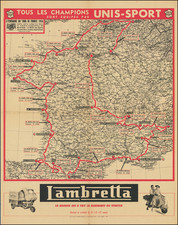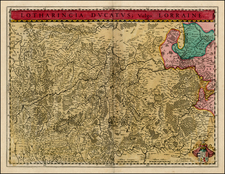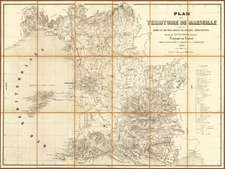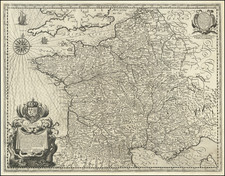A fine example of Nicolas Delamare's map of Ancient Roman Paris, or Lutecia, one of his ground-breaking series of eight maps illustrating the historical development of the French capital.
This fine map depicts Paris during the second half of the 1st-century BC, shortly after the city was conquered by the Romans, who named the town Lutecia. As shown on the map, Lutecia then largely consited of a gathering of huts on the Ile de la Cite, which is connected to both banks of the Seine by bridges. To the southwest and south of the town are the newly built Roman temples to Ceres (the Goddess of Agriculture and Bounty) and Mercury (the God of Travel). To the far northwest is the temple to Mars (the God of War), located on a hill which is the modern-day site of Monmartre.
Lutecia and all of Northern France (or Gaul) was conquered by the Roman legions of Julius Caesar in 52 BC, follwing a Celtic revolt led by Vercingetorix. The city progressively grew to become one of the largest towns in the Roman Empire outside of Italy.
The present map is a separately published example of Delamare's map, which also appeared in the the first edition, first volume of Nicolas Delamare's La Traité de la Police (Paris, 4 vols., 1705-38), considered to be the most influential legal treatise produced in early modern France. It was the first detailed history of law enforcement ever published, and details the development of the subject throughout the history of Paris. In order to illustrate the size and nature of the city during different historical periods, Delamare painstakingly consulted a variety of published and archival sources in order to construct a series of eight maps that progressively depict the evolution of Paris from Roman times up to 1700. All considered, this map represents a fascinating glimpse into Roman Paris, which is today long lost, save for the survival of a handful of ruins. Delamare's maps are, in and of themselves, important, as they represnt the first time that anyone accomplished a systematic historical reconstruction of a city's development.









![[France, Belgium, Switzerland and Gemany]](https://storage.googleapis.com/raremaps/img/small/75179.jpg)


![[France] (2 maps - Ancient & Modern)](https://storage.googleapis.com/raremaps/img/small/70507.jpg)

